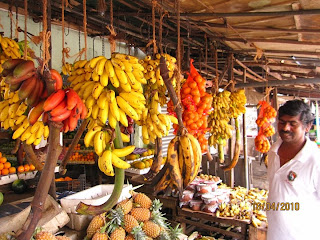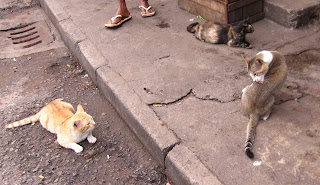After getting our car and driver hired we set the route and out first point of call was Jantar Mantar. It is a compound with huge observation instruments (yantras) for celestial movements, azimuth & altitude and also time. Originally built by the Maharaj Sawai Jai Singhji of Jaipur in 1710 it is still standing (restored 1910) and it is also listed as a UNESCO preservation site. One could still see the carefully carved measuring scales on the stones and each instrument had a plaque explaining for what celestial body was being measured (declination, time, etc). I did not linger long and left for our next stop.
One of the Yantras
Qutb Minar
Next on stop was Qutb Minar (pronounced Qutab) some way from old Delhi. It is a 5-6 story tower in a compound now with a defunct mosque Quwwatul-Islam (Might of Islam) that was built from parts of 27 Jain and Hindu temples in 1197. The mosque had some very beautiful stone carvings.
The old mosque
As a quriosity it has a metal pillar that according to archeologists hails from Bihar and is of hindu origin. The pillar is still perplexing researchers as to why it does not corrode after so many hundreds years. Local superstition says that if you can grasp your hands with your back against the pillar all your troubles will be solved. Unfortunately it was not possible to try it as a fence has been erected around it preventing people from touching it.
The iron pillar
This site is also on the UNESCO protection list, see more here
Me tomb raiding Qutb Minar
The Bahai faith Lotus temple is a huge construct looking like a partially open Lotus flower. We parked at the parking lot after diligent checking of boot and engine compartment with mirrors. Apparently the terror risk is present so no risks are taken for any possible bombings.
Lotus temple
From the parking lot we came by the admin buiding where I suppose the last conversion takes place as it said something like "familiarisation centre". The was along bee line going towards the temple itself and about half way we had to remove our shoes. I've gotten used to that practice in Burma where one must always remove shoes when entering the Temple compound. The ony bad thing here was that the walk way up was done in red sand stone and it was scorching hot. There was a carpet placed that was leading up but it was not much cooler, at least it prevented serious burns to my soles.
Once at the shadow of the Lotus we were arranged in rows and explained in hindi how to behave in the church (no talking, no photos, no running, etc.) and then we were let inside. Once started to walk in one muppet came up to me starting to explain the same thing in English, I did not stop to listen as it was not my first in a church and I had checked up the Bahai faith from before. He seemed a bit peeved about it, but Saini told him he translated the hindi explanation to me already.
Inside was very quiet and peaceful, only birds flying inside the church made some noise. The trappings inside were very simple, plain wooden benches and a small speakers podium (not raised) was in front. At the corners of the Lotus was plaques with words of wisdom from Baha'u'llah, their prophet.
Humayun's tomb
Then it was time to go to the Humayuns tomb (lot of tomb's in Delhi). Actually it is called the "Dormitory of the Mughals" as there are over 100 graves inside the mausoleum. It is a precursor to the Taj Mahal in Agra. This is the earliest example of Persian influenece on Indian architecture, built in 1565. Emperor Akbar i also buried here.
Isa Khan's tomb
While walking towards the Humayun tomb there is another tomb called Isa Khans tomb. According to plaques it used to contain a whole village in the compound once. The wall surrounding the mausoleum has a mosque incorporated and all the trappings for defenses with shooting holes and guard towers.
India Gate
Now we were on the way to India Gate which is a war memorial for all the fallen soldiers in various wars India had praticipated in. An imposing structure even bigger than the Gateway of India in Mumbai. It was guarded by naval soldiers and an eternal flame was burning under it.
The Red Fort was our next to last item on the list, we were becoming a bit overwhelemed of the cultural overload we had been exposing ourselves the whole day but nevertheless we slogged on. The Red Fort is huge constructon in middle of Delhi, just outside the entrance is Chandni Chowk, the famous shopping street. It is also listed as one of the UNESCO world heritage site.
The dry moat
The Fort is surrounded by a moat that according to my guide book has been bone dry for at least the last 200 years. It was very dry but I think a bit more humid than the other dry areas as verdant green shrubbery was covering the bottom.
The throne terrace
We walked in and came to a walkway through the wall that was lined by curio and souvenir shops. Here I bargained myself a small idol of Durga down to 1000Rs from 1800Rs. I think it was a good deal.
Next we came to the Moghul throne hall where the reception of visitors and audiences were carried out. A huge covered terrace (that used to have awnings reaching out from the building) with a dais for the Moghul to sit on.
Moghul's private quarters
Behind this terrace were the Moghuls private quarters, almost same kind of terraces but walled, very airy. built of marble with a shallow water channel going through all the buildings into the hammam. Separately there was a mosque for the Moghul's private use. The private quarters were facing the other side of the Fort and it had a bacony where it was said the Moghul showed himself every day to his people.
By now we were quite tired but decided to visit our last highlight on our list (having deleted the Birla temple and Rajghat), the Akshardam temple. It is supposedly the world's largest hindu temple. It certainly was imposing even from a distance. The parking lot was enormous. We were not allowed anything inside, no cameras, no phones and a long list of other items. It would have been easier to list what is allowed inside. Apparently there had been terror incidents so the security was very strict, we were patted down twice very thoroughly.
Akshardam
So, I was allowed to enter with my wallet and clothes on. The temple had very beautiful carvings of elephants surrounding the mandir (main temple), unfortunately it was closed for renovation. Everywhere else were carvings of all kinds of other animals. We went to a sort of history show where one sat in a boat that followed a channel and was passing exhibits if historical highlights of India. The name was 10000yrs of history in 10minutes. I was too tired to wait for the english boat so I took the hindi boat and relied on Saini's translation, well done exhibit.
There would have also been 2 other shows, the singing fountain and somekind of movie but by now we had our mettle full and so we left the temple not having the patience to queue up. Besides time was running late. At the exit there was a souvenir shop and I could also see what encouraged to keep cameras out of the temple. The sale of postcards was going well. I bought a set + a box of keyrings and at the ayurvedic counter a bottle of Aloe Vera concentrated juice.
The driver picked us up and dropped us off at the local bus station. We tipped him 100Rs on top the fee of 1500Rs and he was quite happy about it. Moreover he had earned another 500Rs on us (kickback) for taking us to a tourist shop where we bought nothing.
More on Akshardam




















































